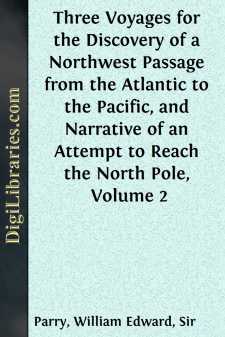Categories
- Antiques & Collectibles 13
- Architecture 36
- Art 48
- Bibles 22
- Biography & Autobiography 813
- Body, Mind & Spirit 142
- Business & Economics 28
- Children's Books 17
- Children's Fiction 14
- Computers 4
- Cooking 94
- Crafts & Hobbies 4
- Drama 346
- Education 46
- Family & Relationships 57
- Fiction 11829
- Games 19
- Gardening 17
- Health & Fitness 34
- History 1377
- House & Home 1
- Humor 147
- Juvenile Fiction 1873
- Juvenile Nonfiction 202
- Language Arts & Disciplines 88
- Law 16
- Literary Collections 686
- Literary Criticism 179
- Mathematics 13
- Medical 41
- Music 40
- Nature 179
- Non-Classifiable 1768
- Performing Arts 7
- Periodicals 1453
- Philosophy 64
- Photography 2
- Poetry 896
- Political Science 203
- Psychology 42
- Reference 154
- Religion 513
- Science 126
- Self-Help 84
- Social Science 81
- Sports & Recreation 34
- Study Aids 3
- Technology & Engineering 59
- Transportation 23
- Travel 463
- True Crime 29
Three Voyages for the Discovery of a Northwest Passage from the Atlantic to the Pacific, and Narrative of an Attempt to Reach the North Pole, Volume 1
Categories:
Description:
Excerpt
CHAPTER I.
Passage across the Atlantic.—Enter Davis's Strait.—Unsuccessful
Attempt to penetrate the Ice to the Western Coast.—Voyage up the
Strait.—Passage through the Ice to the Western Coast.—Arrival
off Possession Bay, on the Southern Side of the Entrance into Sir
James Lancaster's Sound.
In the beginning of May, 1819, the Hecla and Griper were towed down the river; the guns and gunner's stores were received on board on the 6th; and the instruments and chronometers were embarked on the evening of the 8th, when the two ships anchored at the Nore. The Griper, being a slower sailer, was occasionally taken in tow by the Hecla, and they rounded the northern point of the Orkneys, at the distance of two miles and a half; on Thursday, the 20th of the same month.
Nothing of moment occurred for several days; but the wind veered to the westward on the 30th, and increased to a fresh gale, with an irregular sea and heavy rain, which brought us under our close-reefed topsails. At half past one, P.M., we began to cross the space in which the "Sunken Land of Buss" is laid down in Steel's chart from England to Greenland; and, in the course of this and the following day, we tried for soundings several times without success.
Early in the morning of the 18th of June, in standing to the northward, we fell in with the first "stream" of ice we had seen, and soon after saw several icebergs. At daylight the water had changed its colour to a dirty brownish tinge. The temperature of the water was 36½°, being 3° colder than on the preceding night; a decrease that was probably occasioned by our approach to the ice. We ran through a narrow part of the stream, and found the ice beyond it to be "packed" and heavy. The birds were more numerous than usual; and, besides the fulmar peterels, boatswains, and kittiwakes, we saw, for the first time, some rotges, dovekies, or black guillemots, and terns, the latter known best to seamen by the name of the Greenland swallow.
On the clearing up of a fog on the morning of the 24th, we saw a long chain of icebergs, extending several miles, in a N.b.W. and S.b.E. direction; and, as we approached them, we found a quantity of "floe-ice" intermixed with them, beyond which, to the westward, nothing but ice could be seen. At noon we had soundings, with one hundred and twenty fathoms of line, on a bottom of fine sand, which makes it probable that most of the icebergs were aground in this place. In the afternoon we sailed within the edge of the ice, as much as a light westerly wind would admit, in order to approach the western land. Some curious effects of atmospheric refraction were observed this evening, the low ice being at times considerably raised in the horizon, and constantly altering its appearance.
The weather being nearly calm on the morning of the 25th, all the boats were kept ahead, to tow the ships through the ice to the westward. It remained tolerably open till four P.M., when a breeze, freshening up from the eastward, caused the ice, through which we had lately been towing, to close together so rapidly, that we had scarcely time to hoist up the boats before the ships were immovably "beset." The clear sea which we had left was about four miles to the eastward of us, while to the westward nothing but one extensive field of ice could be seen....



